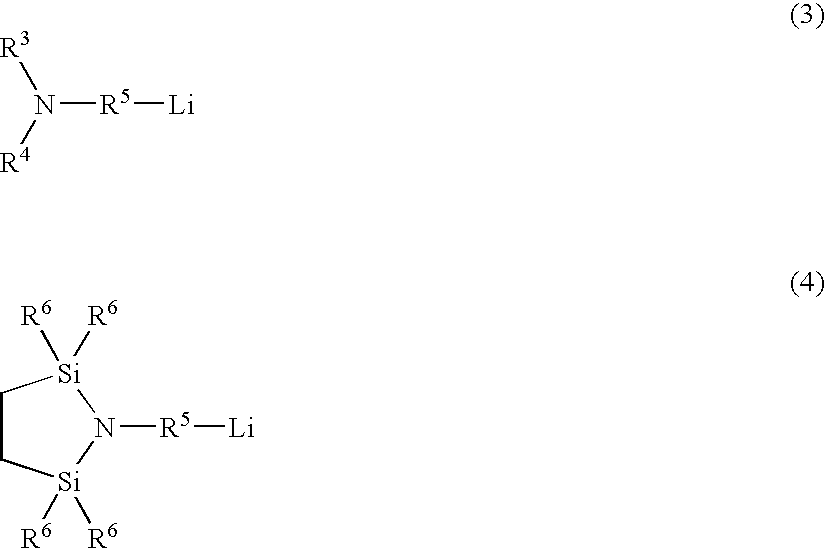Resin composition and molded product thereof
a technology which is applied in the field of resin composition and molded product thereof, can solve the problems of large social problems, large amount of resin thrown away from homes and factories, and serious shortage of burial grounds, and achieves the balance of impact resistance and tensile property or stiffness, and the effect of superior appearan
- Summary
- Abstract
- Description
- Claims
- Application Information
AI Technical Summary
Benefits of technology
Problems solved by technology
Method used
Image
Examples
production example 1
[Production of Functional Group-containing, Hydrogenated, Diene-based Polymer (polymer-1)]
[0100]In a nitrogen-purged reactor having an internal volume of 50 liters were placed cyclohexane (25 kg), tetrahydrofuran (750 g), styrene (2,000 g) and 3-lithio-1-N,N-bis (trimethylsilyl) aminopropane (14.4 g) . Adiabatic polymerization was conducted from 50° C. After the completion of the reaction, the system temperature was lowered to 20° C., 1,3-butadiene (2,500 g) was added, and adiabatic polymerization was conducted. 30 minutes later, styrene (500 g) was added and polymerization was conducted. After the polymerization was over, hydrogen gas was fed at a pressure of 0.4 Mpa-G and stirring was made for 20 minutes, whereby the hydrogen was reacted with polymer terminal lithium (which was a living anion) to form lithium hydride. The reaction mixture was maintained at 90° C. and a hydrogenation reaction was conducted using titanocene dichloride. At the timing when hydrogen absorption was over...
production example 2
[Production of Functional Group-containing, Hydrogenated, Diene-based Polymer (Polymer-2)]
[0102]In a nitrogen-purged reactor having an internal volume of 50 liters were placed cyclohexane (25 kg), tetrahydrofuran (750 g), styrene (500 g) and 2,2,5,5-tetramethyl-1-(3-lithiopropyl)-1-aza-2,5-disilacyclopentane (14.5 g).
[0103]Adiabatic polymerization was conducted from 50° C. (the temperature of polymerization start) . After the completion of the reaction, the system temperature was lowered to 20° C., 1,3-butadiene (4,250 g) was added, and adiabatic polymerization was conducted. 30 minutes later, styrene (250 g) was added and polymerization was conducted. After the polymerization was over, a hydrogenation reaction and solvent removal were conducted in the same manner as in Production Example 1, whereby was obtained a functional group-containing, hydrogenated, diene-based polymer having a A-B-A type structure (a polymer-2).
[0104]The functional group-containing, hydrogenated, diene-base...
production example 3
[Production of Functional Group-containing, Hydrogenated, Diene-based Polymer (Polymer-3)]
[0105]In a nitrogen-purged reactor having an internal volume of 50 liters were placed cyclohexane (25 kg), tetrahydrofuran (750 g), styrene (500 g) and n-butyllithium (4.5 g). Adiabatic polymerization was conducted from 50° C. After the completion of the reaction, the system temperature was lowered to 20° C., 1,3-butadiene (4,250 g) was added, and adiabatic polymerization was conducted. 30 minutes later, styrene (250 g) was added and polymerization was conducted. 4-{2-[N,N-bis(trimethylsilyl)amino]ethyl}styrene (37 g) was added and reacted with the active site of the resulting polymer for 30 minutes. After the reaction was over, a hydrogenation reaction and solvent removal were conducted in the same manner as in Production Example 1, whereby was obtained a functional group-containing, hydrogenated, diene-based polymer having a A-B-A type structure (a polymer-3). The functional group-containing...
PUM
| Property | Measurement | Unit |
|---|---|---|
| Fraction | aaaaa | aaaaa |
| Fraction | aaaaa | aaaaa |
| Fraction | aaaaa | aaaaa |
Abstract
Description
Claims
Application Information
 Login to View More
Login to View More - R&D
- Intellectual Property
- Life Sciences
- Materials
- Tech Scout
- Unparalleled Data Quality
- Higher Quality Content
- 60% Fewer Hallucinations
Browse by: Latest US Patents, China's latest patents, Technical Efficacy Thesaurus, Application Domain, Technology Topic, Popular Technical Reports.
© 2025 PatSnap. All rights reserved.Legal|Privacy policy|Modern Slavery Act Transparency Statement|Sitemap|About US| Contact US: help@patsnap.com



